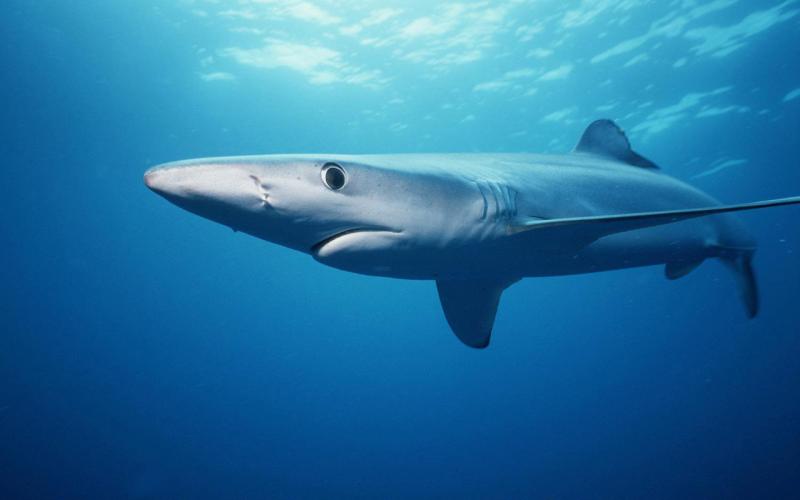Wielding two venomous spines and growing as long as 4 feet, Atlantic spiny dogfish can often be seen hunting prey in dog-like packs (hence the dog-like name). Today, these little sharks are the most commonly caught and exported U.S. shark species, but that wasn’t always the case.
Spiny dogfish were once one of the most abundant shark species in the world. They were historically considered a nuisance by many fishermen who believed they ate young Atlantic cod and other high-priced species. However, NOAA Fisheries shark scientist Dr. Tobey Curtis said studies of spiny dogfish diets do not support this perception.
Smaller spiny dogfish tend to feed primarily on crustaceans, while larger dogfish eat jellyfish, squid, and schooling fish. Cod, red hake, goosefish, other spiny dogfish, larger sharks, seals, and killer whales all prey on dogfish. Dogfish also have a habit of getting caught in fishing nets due to their small size, resulting in bycatch.
History of the Atlantic Spiny Dogfish Shark Fishery
Very few U.S. fishing vessels targeted Atlantic spiny dogfish in the early 20th century. That changed at the start of World War II, when foreign seafood imports were greatly reduced. This forced the U.S. to look to domestic seafood sources to supply the wartime population with nutritious options. Atlantic spiny dogfish were plentiful in U.S. waters and became one of the most sought after shark species. They were mainly used in the production of Vitamin A supplements (shark liver oil is naturally high in Vitamin A).

Shortly after the war, scientists discovered how to create synthetic Vitamin A and demand waned for spiny dogfish domestically. Their light, white meat found a strong market abroad, and today spiny dogfish is still one of the primary species used in British “fish and chips” and other European dishes. As a result, they are the top shark species caught in U.S. waters by volume and make up a major proportion of U.S. seafood exports. In 2017, commercial landings of spiny dogfish in the Atlantic totaled more than 21.5 million pounds, and were valued at more than $3.3 million.
According to a 2015 Food and Agriculture Organization of the United Nations report, the United States exported an average of $11.8 million in shark products per year from 2000-2011. Dogfish species accounted for 64 percent of total shark export volume and 72 percent of total shark export value. The majority of dogfish exports shipped to the European Union.
Seafood suppliers have tried to build a market for spiny dogfish in the United States, but Americans favor other white fish. Marketing companies even suggested changing the spiny dogfish common name to make it sound more appealing to U.S. consumers, but market growth has been slow to progress.
Rebuilding and Sustaining the Fishery
Despite a lack of interest on this side of the pond, demand for this small shark has remained high. This is likely due to the collapse of European dogfish stocks in the late 1980s.
Atlantic spiny dogfish also experienced a decline in U.S. waters in the late 1980s to 1990s, said Michael Ruccio, Supervisory Fisheries Policy Analyst for NOAA Fisheries Greater Atlantic Region. Actions taken by the New England and Mid-Atlantic Fishery Management Councils, along with NOAA Fisheries, established measures to rebuild the fishery. “NOAA Fisheries notified the Councils that the stock was overfished in 1998 and a formal rebuilding plan was put in place in 2000,” Ruccio said. By 2010, the Atlantic spiny dogfish fishery was officially declared rebuilt.
Rebuilding a fishery over many years is no easy task. Spiny dogfish can be particularly difficult to manage because dogfish mothers carry their young for up to two years. This is one of the longest confirmed pregnancies of any vertebrate. Combined with the fact that female spiny dogfish take up to 12 years to reach sexual maturity, this could make it more difficult for spiny dogfish to replenish their population if overfished.
The species is currently undergoing a downturn in population numbers, but this was expected. NOAA Fisheries scientists projected that the number of mature Atlantic spiny dogfish females would decline somewhat due to the low number of pups born during the 1990s, when spiny dogfish were heavily fished. This decline is not expected to result in the stock becoming overfished in the future. Scientists will re-evaluate the fishery status in 2021 during the next spiny dogfish stock assessment.
The Impact of Sustainable Shark Management
The Atlantic spiny dogfish is just one example that sustainable shark management is working in the United States. Of all the shark species managed in U.S. Atlantic waters, none are endangered. We are currently working to rebuild overfished species such as the dusky and mako shark.
Science-based shark management has resulted in healthy, resilient stocks. Continued outreach campaigns have done much to educate U.S. fishermen and coastal communities about the economic and ecological benefits of robust shark populations.
“Healthy oceans have healthy shark populations,” said Dr. Curtis. “NOAA Fisheries has a proven track record of ending overfishing and rebuilding vulnerable shark stocks using science-based regulations and strong enforcement. We continue to make progress in sustaining both sharks and the fishing communities that rely on them.”




